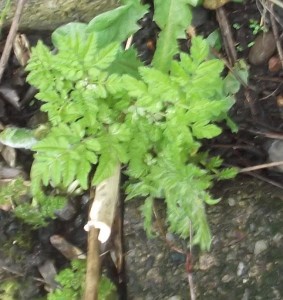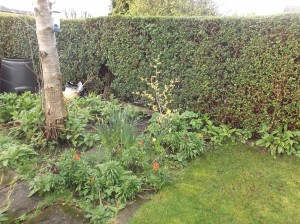 Or, as our local biodiversity group once unappetisingly referred to it, dog’s flourish. No wonder it didn’t get to be our county flower – instead we had the Scottish Dock. Honest.
Or, as our local biodiversity group once unappetisingly referred to it, dog’s flourish. No wonder it didn’t get to be our county flower – instead we had the Scottish Dock. Honest.
Meanwhile this delightful but rather pushy plant was cast aside. It looks lovely now, very delicate and ferny, vigorous and a bright light green – just what the earth needs in spring. And it has frothy creamy flowers and spectacular seed pods. It grows very high in good soil – a good four feet if it gets any encouragement at all, and has a light fresh sweet smell, which gives it the Latin name myrrhis odorata.
On the downside, those seeds spread like dandelions, and the plant has a taproot that goes down incredibly far – ‘down to the pipes’ as we used to say as children, when we dug up the garden to make secret tunnels. It can become a menace, but what can you do? You are just so glad to see that embryonic green bursting through the cold soil, you can’t bear to cut it back. If you don’t want a sweet-melling jungle, however, you can always cut it down just before the seeds set. It will put on a second spurt, but smaller, and you won’t have a mass of decaying foliage collapsing over your border.
The leaves have traditionally been used to sweeten rhubarb, and people have eaten the roots. And all the herbals say that the seeds are used to ‘polish oak’. I’ve tried. I’ve tried them green and I’ve tried them dry, and I’ve tried infusing them in oil. It doesn’t work. What you have to do, I recently discovered after years of seeing this cut and pasted into every herbal in print, is to take off the hard husk, and grind the oily kernel. I think I’m going to have to give this a go come August, and see. The other injunction, to dry the leaves for pot pourri, is a bust. When the leaves are dry the scent has gone. And the elusive art of making the moist kind of pot pourri has so far escaped me. But I’ll have one more try.
 This is the birch border at the end of our garden. It’s coming on very well, what with primroses and hellebores and wild daffodils. There are more here, in the rowan border, under the witch hazel.
This is the birch border at the end of our garden. It’s coming on very well, what with primroses and hellebores and wild daffodils. There are more here, in the rowan border, under the witch hazel.
 The wallflowers are quite advanced, but that is because they missed their cue last year, and so I left them in. And this is Lucy’s garden. There will be annuals here later, nigella and cornflower, cosmos and poppies.
The wallflowers are quite advanced, but that is because they missed their cue last year, and so I left them in. And this is Lucy’s garden. There will be annuals here later, nigella and cornflower, cosmos and poppies.
 Outside the garden, the hawthorn bushes are in tiny leaf and the birds are courting and nest-building, and singing lustily in the early mornings. The first few black-backed gulls have come back from the coast, and they are choosing the best sites on the warehouse roof. The chimneys have gone already, but there’s a fair bit of mossy flat slabs available yet. There are sparrows nesting in last year’s housemartin’s nest, and frogs mating frantically in every pond in the village. And there are skylarks singing in the fields of winter barley!
Outside the garden, the hawthorn bushes are in tiny leaf and the birds are courting and nest-building, and singing lustily in the early mornings. The first few black-backed gulls have come back from the coast, and they are choosing the best sites on the warehouse roof. The chimneys have gone already, but there’s a fair bit of mossy flat slabs available yet. There are sparrows nesting in last year’s housemartin’s nest, and frogs mating frantically in every pond in the village. And there are skylarks singing in the fields of winter barley!
Leave a Reply